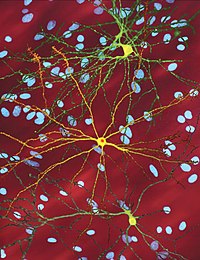
Photo from wikipedia
Huntington’s disease (HD) is a neurogenetic condition with a dramatic impact on the lives of people who carry the pathological CAG repeat number in the HTT gene. In contrast with… Click to show full abstract
Huntington’s disease (HD) is a neurogenetic condition with a dramatic impact on the lives of people who carry the pathological CAG repeat number in the HTT gene. In contrast with other neurodegenerative movement disorders in which the clinical diagnosis remains a gold standard, the discovery of the HTT gene mutation brought certainty to the diagnosis of HD in life. It allowed clinical research to cover a wider spectrum of the natural history of the disease long before the onset of definite clinical features, most commonly motor, that enable a clinical diagnosis. In the last few decades, the HD field witnessed the conduction of large observational studies, such as PREDICT-HD, COHORT, REGISTRY, TRACK-HD/TRACKON-HD, and, more recently, Enroll-HD. These studies contributed immensely to characterization of the phenotypic changes that occur at different phases of the disease using traditional clinical rating scales, neuroimaging, and other biomarkers. This knowledge has permitted development of staging classification systems intended to provide a measure of the progression of the disease. One of the earliest, and still commonly used today, is the Shoulson-Fahn staging system based on the Total Functional Capacity subscale of the Unified Huntington’s Disease Rating Scale. More recently, and following other attempts to present the natural history of HD in successive discrete phases or stages, a robust evidence-based classification system for staging has been proposed: the HD Integrative Staging System, which includes the full course of HD from birth to death. It is divided into four stages that offer a classification of individuals based on landmark assessments (clinical and neuroimaging). In this issue of Movement Disorders, Mohan and colleagues propose a novel approach to explain the clinical progression of HD based on a probabilistic model that defines nine disease states that cover about 36 years of the natural history of clinical disease based only on motor, cognitive, and functional measures, which is remarkable. An important explanation provided by the authors is the differences that a multistate approach has with more common staging classification systems. Instead of determining landmark events that allocate an individual into a given stage using often illdefined definitions, HD clinical phenotypes in this model were first segregated into different clusters (or states), which were then checked in successive validation iterations for consistency with the clinical disease, for example, in terms of the expected temporal order of events and decline in the different clinical domains of HD. As a result, the model proposes the presence of subtle initial motor and cognitive changes before a motor clinical diagnosis (states 1–2, “early disease,” a 16-year span), followed by the “transition” period (states 3–5, a 10-year span) during which a motor clinical diagnosis is established and there is a deterioration of functional ability that ultimately leads to a “late disease” phase (states 6–9, a 10-year span). The authors used probabilistic machine learning methods (Bayesian latent variable analysis followed by continuous-time hidden Markov model). The results presented in this article are a powerful example of how artificial intelligence methodology can discover patterns based on big data analyses. The reader may be less familiar with these emerging concepts that are bound to become more common in our field. The probabilistic machine learning methods used in this study have been used to describe the dynamics of disease processes in other conditions. The greatest advantage is the ability to integrate the common discreteness of data collected in a finite number of clinical visits that occur over time and ultimately provide a fragmented evaluation of © 2022 International Parkinson and Movement Disorder Society
Journal Title: Movement Disorders
Year Published: 2022
Link to full text (if available)
Share on Social Media: Sign Up to like & get
recommendations!